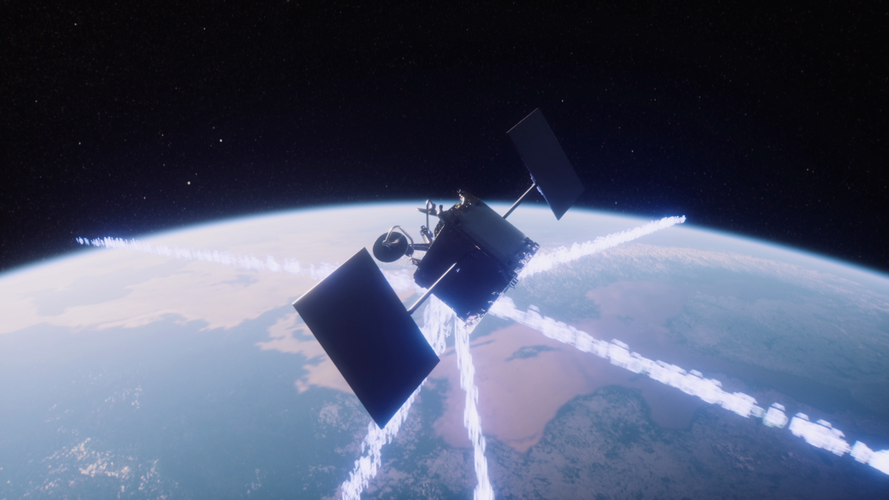Exolaunch to deploy satellites with new universal adapter in 2026
Wednesday, 20 November 2024 12:09

Fly around Ares Vallis on Mars
Wednesday, 20 November 2024 12:00 Video:
00:04:30
Video:
00:04:30
Explore the immense power of water as ESA’s Mars Express takes us on a flight over curving channels, streamlined islands and muddled ‘chaotic terrain’ on Mars, soaking up rover landing sites along the way.
This beautiful flight around the Oxia Palus region of Mars covers a total area of approximately 890 000 km², more than twice the size of Germany. Central to the tour is one of Mars’s largest outflow channels, Ares Vallis. It stretches for more than 1700 km and cascades down from the planet’s southern highlands to enter the lower-lying plains of Chryse Planitia.
Billions of
5G satellites for sustainable agriculture and disaster relief
Wednesday, 20 November 2024 09:59
ESA is working on 5G-HOSTS-SAT to demonstrate how 5G satellite and terrestrial communication networks can work together to solve real-world challenges. The project focuses on two critical areas: smart agriculture and emergency response.
Latitude signs multi-launch contract with Atmos Space Cargo
Wednesday, 20 November 2024 09:28

New full Sun views show sunspots, fields and restless plasma
Wednesday, 20 November 2024 09:00
Zoom into Solar Orbiter's four new Sun images, assembled from high-resolution observations by the spacecraft's PHI and EUI instruments made on 22 March 2023. The PHI images are the highest-resolution full views of the Sun's visible surface to date, including maps of the Sun's messy magnetic field and movement on the surface. These can be compared to the new EUI image, which reveals the Sun's glowing outer atmosphere, or corona.
ESA’s Space Systems for Safety and Security (4S) programme
Wednesday, 20 November 2024 08:50 Video:
00:02:18
Video:
00:02:18
At ESA, through the Advanced Research in Telecommunications Systems programme, we’re addressing solutions for when safety and security of communication services cannot be guaranteed by the terrestrial networks alone. With our programme Space systems for Safety and Security, or 4S, we are pioneering cutting-edge development of secure and resilient satellite communication systems, technologies and services to improve life on Earth.
Picture a world where our critical infrastructure is protected from cyber threats, and where communication links work when the world around them doesn't. A transportation network where safety is not just a priority, but a guarantee. Where air traffic flows
SpaceX launches giant Starship rocket, but aborts attempt to catch booster with mechanical arms
Wednesday, 20 November 2024 08:35This request seems a bit unusual, so we need to confirm that you're human. Please press and hold the button until it turns completely green. Thank you for your cooperation!
Press and hold the button
If you believe this is an error, please contact our support team.
185.132.36.159 : 6850a0a1-0026-479f-bfd0-e45851b7
Arianespace to launch Exotrail's Spacevan on Ariane 6
Wednesday, 20 November 2024 07:07 Arianespace has secured a contract to launch Exotrail's spacevan, marking its first GEO mission as an auxiliary payload aboard the Ariane 64 configuration of the Ariane 6 launcher. The mission, set for the latter half of 2026, will depart from Europe's Spaceport in French Guiana. This version of Ariane 6, equipped with four solid boosters, will carry the spacevan into a Geostationary Transfer Or
Arianespace has secured a contract to launch Exotrail's spacevan, marking its first GEO mission as an auxiliary payload aboard the Ariane 64 configuration of the Ariane 6 launcher. The mission, set for the latter half of 2026, will depart from Europe's Spaceport in French Guiana. This version of Ariane 6, equipped with four solid boosters, will carry the spacevan into a Geostationary Transfer Or ESA set to advance European launch services with a Boost!
Wednesday, 20 November 2024 07:07 Several European space companies are gearing up for their inaugural rocket launches, a crucial phase akin to a startup's first product debut but with significant operational challenges and financial pressures. To support these companies during this period, ESA has allocated euro 44.22 million in co-funding, reinforcing its commitment to assist the space sector as it moves from development to re
Several European space companies are gearing up for their inaugural rocket launches, a crucial phase akin to a startup's first product debut but with significant operational challenges and financial pressures. To support these companies during this period, ESA has allocated euro 44.22 million in co-funding, reinforcing its commitment to assist the space sector as it moves from development to re NASA to assign cargo missions to SpaceX and Blue Origin for Artemis
Wednesday, 20 November 2024 07:07 NASA is set to deepen its Artemis campaign, targeting long-term lunar exploration, by assigning key cargo missions to SpaceX and Blue Origin under their current contracts. This move supports NASA's goal of fostering scientific advancement and sustainable operations on the Moon.
Following successful design certification reviews, NASA plans to award demonstration missions to SpaceX and Blue
NASA is set to deepen its Artemis campaign, targeting long-term lunar exploration, by assigning key cargo missions to SpaceX and Blue Origin under their current contracts. This move supports NASA's goal of fostering scientific advancement and sustainable operations on the Moon.
Following successful design certification reviews, NASA plans to award demonstration missions to SpaceX and Blue Researcher explore dark matter's origins in potential dark Big Bang event
Wednesday, 20 November 2024 07:07 Recent findings from Colgate University's Department of Physics and Astronomy have opened up intriguing possibilities about the origins of dark matter, which could reshape current scientific perspectives.
Assistant Professor Cosmin Ilie and senior Richard Casey examined the theory advanced by Katherine Freese and Martin Winkler from the University of Texas at Austin, suggesting dark matter
Recent findings from Colgate University's Department of Physics and Astronomy have opened up intriguing possibilities about the origins of dark matter, which could reshape current scientific perspectives.
Assistant Professor Cosmin Ilie and senior Richard Casey examined the theory advanced by Katherine Freese and Martin Winkler from the University of Texas at Austin, suggesting dark matter Orion Space Solutions set to enhance on-orbit refueling for U.S. Space Force
Wednesday, 20 November 2024 07:07 Orion Space Solutions (Orion), a subsidiary of Arcfield, has secured an additional contract from the U.S. Space Force (USSF) Space Systems Command (SSC) to extend its work on the Tetra-6 mission. This four-year award builds upon Orion's existing Tetra-5 prime contract, focusing on advancing refueling technologies in space.
The Tetra-6 mission aims to showcase a distinct refueling approach
Orion Space Solutions (Orion), a subsidiary of Arcfield, has secured an additional contract from the U.S. Space Force (USSF) Space Systems Command (SSC) to extend its work on the Tetra-6 mission. This four-year award builds upon Orion's existing Tetra-5 prime contract, focusing on advancing refueling technologies in space.
The Tetra-6 mission aims to showcase a distinct refueling approach 'Harness the now': British singer Imogen Heap embraces AI
Wednesday, 20 November 2024 07:07 Unlike the bulk of her peers, Grammy-winning British singer Imogen Heap is embracing the use of artificial intelligence (AI) in her music as well to set up a music collaboration platform.
"I am excited about AI because I feel maybe it can help humans harness the now," she told AFP on the sidelines of the four-day Web Summit tech conference in Lisbon which wrapped up on Thursday.
The two-
Unlike the bulk of her peers, Grammy-winning British singer Imogen Heap is embracing the use of artificial intelligence (AI) in her music as well to set up a music collaboration platform.
"I am excited about AI because I feel maybe it can help humans harness the now," she told AFP on the sidelines of the four-day Web Summit tech conference in Lisbon which wrapped up on Thursday.
The two- 



